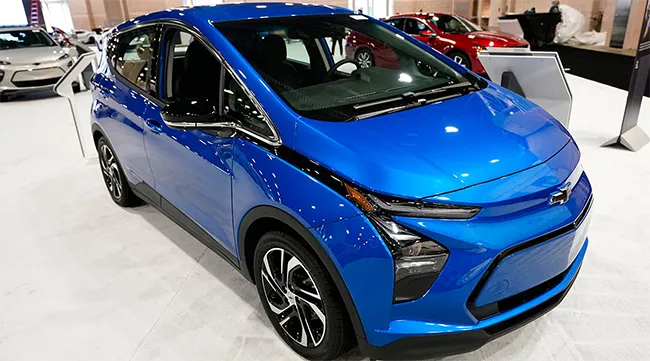General Motors Profit Rises 15% in Q2

[Stay on top of transportation news: Get TTNews in your inbox.]
DETROIT — U.S. customers who bought a new General Motors vehicle last quarter paid an average of just under $49,900, a price that helped push the company’s net income 15% above a year ago.
And GM Chief Financial Officer Paul Jacobson said he doesn’t see his company cutting prices very much, despite industry analysts’ predictions of growing U.S. new-vehicle inventories and bigger discounts.
Shares of General Motors Co. jumped 5% before the opening bell July 23, closing in a high point for 2024.
The Detroit automaker made $2.92 billion from April through June and posted revenue of $47.97 billion. Excluding one-time items, the company made $3.06 per share, 35 cents above Wall Street estimates, according to data provider FactSet, and revenue was better than expected as well.

The autonomous vehicle unit will rely on next-generation Chevrolet Bolt electric vehicles. (Matt Rourke/Associated Press)
While the average sales price was down slightly from a year ago, GM sold 903,000 vehicles to dealers in North America during the quarter, 70,000 more than the same period in 2023. Sales in its international unit, however, fell 7,000 to 140,000, the company said.
Early in the year GM predicted that prices would drop 2% to 2.5% this year, but so far that hasn’t materialized, Jacobson said. Instead, the company now expects a 1% to 1.5% decline in the second half.
GM’s prices were down slightly, Jacobson said, because a greater share of its sales have come from lower-priced vehicles such as the Chevrolet Trax small SUV, which starts at $21,495 including shipping. The company, he said, has seen strong sales of higher-priced pickup trucks and larger SUVS.
The company posted its best quarterly sales since the final three months of 2020, Wedbush analyst Dan Ives pointed out.
“We believe the long-awaited turnaround for the GM story is now underway with stable pricing across its portfolio while focusing more on margins and capital efficiency,” Ives wrote.
Jeff Loftus of FMCSA joins TT’s Seth Clevenger to discuss the current outlook on ADAS technology and how it will affect the industry at large. Tune in above or by going to RoadSigns.ttnews.com.
Industrywide, U.S. buyers paid an average of $47,616 per vehicle in June, down 0.7% from a year ago, according to Edmunds.com. Discounts per vehicle more than doubled from a year ago to $1,819.
U.S. new-vehicle inventory has grown to just under 3 million vehicles, up from about 1.8 million a year ago.
While other companies have raised discounts, GM has been able to stay relatively consistent while gaining U.S. market share, Jacobson said.
“To date, what we’ve seen in July so far, is it looks very, very similar to June,” Jacobson said. The company is “making sure we put products in the market that our customers love, and the pricing takes care of itself,” he said.
Sales and pricing were among the reasons why GM reduced its net income guidance only slightly for the full year, from a range of $10.1 billion to $11.5 billion, to a new range of $10 billion to $11.4 billion.
GM also said it expects to manufacture and sell 200,000 to 250,000 electric vehicles this year. In the first half, though, it has sold only 22,000 in the U.S., its largest market.
Jacobson conceded the company has some ground to cover to hit its full-year targets, but said the new Chevrolet Equinox small SUV is just reaching showrooms, and production of other models is rising as battery plants in Tennessee and Ohio ramp up their output.
Want more news? Listen to today's daily briefing above or go here for more info
The company, he said, will add $400 million to its first-half spending on marketing from July through December, in part to raise awareness of its EVs. The annual spending on marketing, though, will still be lower than in 2023, he said.
GM spent $500 million during the second quarter on its troubled Cruise autonomous vehicle unit, $100 million less than a year ago. The company said it would indefinitely postpone building the Origin, a six-passenger robotaxi that was planned for Cruise.
The autonomous vehicle unit will rely on next-generation Chevrolet Bolt electric vehicles when it tries to resume carrying passengers without human safety drivers.
Cruise lost its license to autonomously haul passengers in California last year after one of its robotaxis dragged a jaywalking pedestrian — who had just been struck by a vehicle driven by a human — across a darkened street in San Francisco before coming to a stop.
GM had hoped Cruise would be generating $1 billion in annual revenue by 2025, but has scaled back massive investments in the service.





